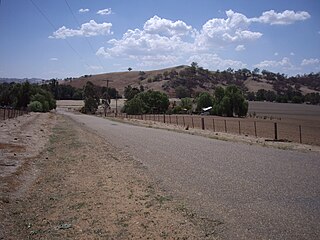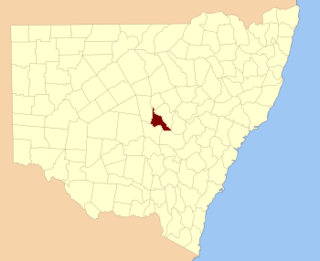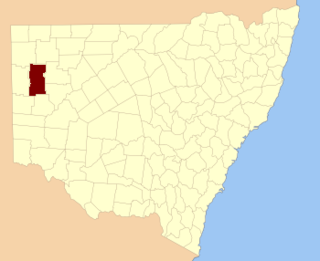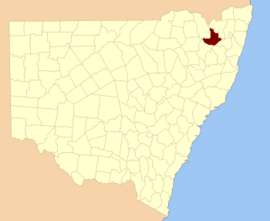
Gough Island, also known historically as Gonçalo Álvares after the Portuguese explorer, is a rugged volcanic island in the South Atlantic Ocean. It is a dependency of Tristan da Cunha and part of the British overseas territory of Saint Helena, Ascension and Tristan da Cunha. It is about 400 km (250 mi) south-east of the Tristan da Cunha archipelago, 2,400 km (1,500 mi) north-east from South Georgia Island, 2,700 km (1,700 mi) west from Cape Town, and over 3,200 km (2,000 mi) from the nearest point of South America.

The South Creek or Wianamatta, a creek that is part of the Hawkesbury-Nepean catchment, is located on the Cumberland Plain, also referred to as Greater Western Sydney, New South Wales, Australia.
The Geographical Names Board of New South Wales, a statutory authority of the Land and Property Information division, Department of Finance and Services in the Government of New South Wales, is the official body for naming and recording details of places and geographical names in the state of New South Wales, Australia.

Wolli Creek is an urban watercourse of the Cooks River catchment located in the southern suburbs of Sydney, in New South Wales, Australia.
Michael Andrew Gough is an English former domestic cricketer and umpire. He was a right-handed batsman and a right-arm off-break bowler. Gough is an international umpire and is a member of the Elite Panel of ICC Umpires, representing the England and Wales Cricket Board.

Ian Gough is a former Wales international rugby union footballer. His usual position was lock forward. He made his debut for the Wales national rugby union team against South Africa in 1998, and was a regular thereafter, including playing in the 2006 Six Nations Championship, and the mid year series against Argentina. He also played within the Irish under-19 international team.

Darbalara is a rural community on the east bank of the junction of the Murrumbidgee River and Tumut River in the Riverina. It is situated by road, about 25 kilometres north east of Gundagai and 25 kilometres south of Coolac.

Gloucester County was one of the original Nineteen Counties in New South Wales, and is now one of the 141 cadastral divisions of New South Wales. It includes the area around Port Stephens. It is bounded on the north and west by the Manning River, and on the south-west by the Williams River.

St Vincent County was one of the original Nineteen Counties in New South Wales and is now one of the 141 Cadastral divisions of New South Wales. It included the south coast area encompassing Batemans Bay, Ulladulla, Jervis Bay and inland to Braidwood. The Shoalhaven River is the boundary to the north and west, and the Deua River the boundary to the south.

Cowper County, New South Wales is one of the 141 Cadastral divisions of New South Wales.

Kennedy County is one of the 141 Cadastral divisions of New South Wales. It is located to the west of the Bogan River in the area around Tottenham and Tullamore.

Mootwingee County, New South Wales is one of the 141 Cadastral divisions of New South Wales.
Armidale was an electoral district of the Legislative Assembly in the Australian state of New South Wales, originally created in 1894, partly replacing New England, and named after and including Armidale. In 1920, with the introduction of proportional representation, it was absorbed into Northern Tablelands, along with Gough and Tenterfield. It was recreated in 1927 and abolished in 1981 and partly replaced by the recreated Northern Tablelands.
Gough was an electoral district of the Legislative Assembly in the Australian state of New South Wales, which replaced Glen Innes and part of Gwydir in 1904 and was named after the Gough County, which includes the town of Glen Innes. In 1920, with the introduction of proportional representation, it was absorbed into Northern Tablelands, along with Armidale and Tenterfield.
Tenterfield was an electoral district of the Legislative Assembly in the Australian state of New South Wales, originally created in 1859, partly replacing New England and Macleay, and named after, and including, Tenterfield. In 1920, with the introduction of proportional representation, it was absorbed into Northern Tablelands, along with Armidale and Gough. It was recreated in 1927 and abolished in 1981 and partly replaced by the recreated Northern Tablelands.
Glen Innes was an electoral district of the Legislative Assembly in the Australian state of New South Wales, named after Glen Innes. It was created in 1880 and gained a second member in 1889, with voters casting two votes with the two leading candidates being elected. In 1894, it became a single-member electorate and, in 1904, it was abolished and replaced by Gough.

The Gough Map or Bodleian Map is a Late Medieval map of the island of Great Britain. Its precise date of production and authorship are unknown. It is named after Richard Gough, who bequeathed the map to the Bodleian Library in 1809. He acquired the map from the estate of the antiquarian Thomas "Honest Tom" Martin in 1774. Numerous copies of it have been made, with an interactive online version created at Queen's University, Belfast. It measures 115 x 56 cm.
John George Gough, was one of the founders of the New South Wales Labour Party, initially the Labour Electoral League, the first political Labour movement in Australia. He was also one of Labour's five-member leadership group when the party first made its appearance in the New South Wales parliament in 1891. Representing Young, he was first elected in 1889 to the parliament's lower house as a member of the Protectionist Party, which produced Australia's first two prime ministers, Edmund Barton and Alfred Deakin. From 1891 to 1894 he represented Labour. Proud that his mother was Australian-born, he was a strong nationalist and republican. John Gough’s maternal grandmother was half-aboriginal. He is the only one of Labor’s founding fathers who has been found to have had aboriginal ancestry.

Tallawong railway station, originally known as Cudgegong Road railway station, is a station near the intersection of Cudgegong and Schofield Roads, Rouse Hill, in Sydney, Australia. The station is the terminus of the Metro North West Line to Chatswood that will later be extended through the Sydney central business district to Bankstown. Beyond the station lies a train depot.

Blowering, New South wales is a rural locality in the Snowy Mountains of New South wales and a civil Parish of Buccleuch County.















